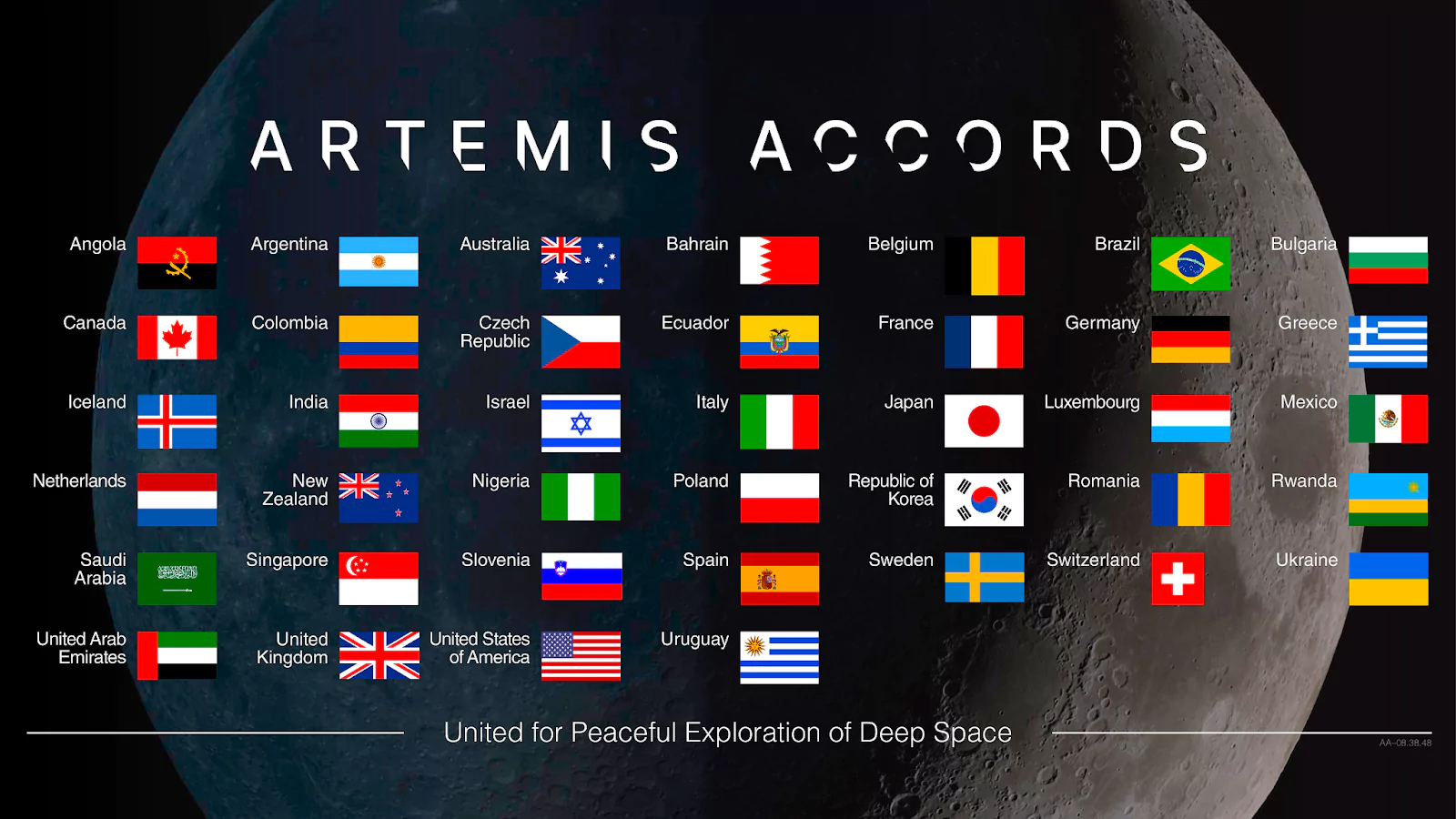Context
Recently, Slovenia & Sweden became the 39th & 38th Countries to sign Artemis Accords respectively.
About Artemis Accords
- Artemis Accords is a US-led alliance seeking to facilitate international collaboration in planetary exploration and research.
- It relates to activities in orbit, on the surface, and in the subsurface of the moon, Mars, comets, and asteroids.
- It also covers the stable orbital points known as the Lagrangian points for the Earth-moon system).
- Artemis Accords Established by: It was launched on October 13, 2020 with Australia, Canada, Italy, Japan, Luxembourg, the United Arab Emirates, the United Kingdom and the United States.
- Artemis Accords Members:
- The Accords have been signed by 39 countries till now.
- On June 21,2023 India became the 27th country to sign the Artemis Accords.
- China and Russia are not part of this initiative.

Key Principles of Artemis Accords
These are a non-binding set of principles designed to guide civil space exploration and use in the 21st century.
Enroll now for UPSC Online Course
- To affirm the countries comply with
- 1967’s Outer Space Treaty,
The Outer Space Treaty:
- It was adopted by the United Nations in 1967.
- It primarily addresses the
- Peaceful use of outer space and prohibits the placement of nuclear weapons in space.
- Provisions related to space debris and the return of space objects to Earth.
- Damage caused by space objects to other space assets.
- It also applies to damage caused by falling objects on earth.
Rescue and Return Agreement 1968
- Earlier known as ‘Agreement on the Rescue of Astronauts, the Return of Astronauts and the Return of Objects Launched into Outer Space’(ARRA).
- It outlines the responsibilities of the states to assist & rescue astronauts in distress and promptly return them to the launching State.
- Also, for the Recovering of space objects.
The Liability Convention, 1972: (Convention on International Liability for Damage Caused by Space Objects)
- Most space-faring countries are signatories to this Convention.
- This convention is one of the several international agreements that complement the Outer Space Treaty, the overarching framework guiding the behavior of countries in space.
Registration Convention,1975 (Convention on Registration of Objects Launched into Outer Space)
- To provide means and procedures to assist in the identification of objects launched into outer space(space objects) and to make provisions for their registration
|
-
- Rescue and Return Agreement 1968 (which emphasizes the responsibility of nations to safely return astronauts),
- 1972’s Liability Convention and
- 1975’s Registration Convention.
- Peaceful Exploration of Space: All activities must be conducted peacefully in line with international law.
- Transparency: Signatories must be transparent about their activities and share scientific information openly.
- Interoperability: Nations should develop systems that can work together to enhance safety and sustainability.
- Emergency Assistance: Commitment to assisting personnel in distress in outer space.
- Registration of Space Objects: Agreement on registering relevant space objects.
- Preserving Heritage: Commitment to preserving historic sites and artifacts in space.
- Space Resources: Affirmation of the importance of extracting and utilizing space resources, with transparency to the international community.
- Deconfliction of Activities: Prevention of harmful interference and establishment of safety zones.
- Orbital Debris Management: Planning for the safe disposal of debris and limiting the generation of new debris.
NASA’s ARTEMIS Programme (mission to the Moon):
- Named after Apollo’s twin sister in Greek mythology : Aimed at returning to the moon, setting up a permanent station there, and then using it for deep space exploration.
- ARTEMIS stands for
- ‘Acceleration, Reconnection, Turbulence and Electrodynamics of Moon’s Interaction with the Sun.’
- As part of the programme,
- Artemis-1 Mission in 2022 : An unmanned Orion spacecraft aboard its new-age heavy duty rocket called Space Launch System or SLS.
- The Orion spacecraft went around the moon and came back to Earth on December 11, 2022.
- Artemis II Launch: Crewed Lunar Flyby Mission:
- After September 2025, Artemis-II will mark the first crewed mission under the Artemis program, with four astronauts planned to be on board during the 10-day mission.
- Artemis III, a mission that will land the first female astronaut and first astronaut of color on the Moon
- It will allow astronauts to land on the lunar surface and study the lunar surface more extensively.
|
Also Read: India And The Artemis Accords
![]() 20 Apr 2024
20 Apr 2024

